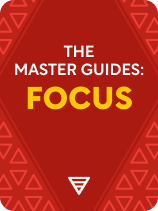

This article is an excerpt from the Shortform book guide to "The Master Guides: Focus" by Shortform. Shortform has the world's best summaries and analyses of books you should be reading.
Like this article? Sign up for a free trial here.
Want to learn how to create an action plan on how to achieve goals? How can you choose what to focus on and start planning?
If you’re struggling to figure out where to focus your energy, creating an action plan can help you prioritize and take actionable steps toward achieving your goals. According to experts, knowing where to focus your energy is the most essential step you must take when goal setting.
Read on to learn how to achieve your goals by creating an action plan.
How to Achieve Goals: Create an Action Plan
Do you often feel that there isn’t enough time to finish all the projects you’d like to get done? Many authors agree that the ability to concentrate is key to fulfillment, and they also agree that focus is a skill you have to learn through practice and deliberate repetition. Since experts claim that the most essential step is to choose where to focus your attention, let’s take a look at creating an action plan on how to achieve goals, according to their tips.
Tips for Making an Action Plan
Tip #1: Select one priority per day. In Make Time, Jake Knapp and John Zeratsky suggest that the most important step to creating an action plan and being proactive with your attention is to choose one goal to focus on each day that you want to achieve. This won’t be the only thing you do, but it’s the one thing you’ll prioritize over everything else. It might be a project you’ve been putting off at work, or it might be something you’ve always meant to do in your free time. Whatever you choose, it’s the thing you’ll look back on with a feeling of satisfaction, or even joy, at having accomplished. But be flexible. Where you focus your attention doesn’t need to be set in stone; you can change it at any point throughout the day.
Tip #2: List the steps for reaching your goal. In Eat That Frog!, business consultant Brian Tracy says that the best way to overcome distraction and make a big job doable is by breaking it into smaller steps and focusing on one step at a time. When you make an action plan for the goals you want to achieve and how you’ll achieve them, using a list gives you a visual representation of the process, increasing the chances you’ll achieve them on schedule. Prioritize your tasks, and list things in the order they need to be done. You may want to depict your plan with boxes, circles, and arrows to help show the relationships between tasks. With a written goal and a plan, you’ll be far more productive than if you had only a mental list.
Tip #3: Ask the Focusing Question. Gary Keller, author of The One Thing, says that to determine where you should direct your time and energy, ask the Focusing Question: “What’s the one thing I can do such that by doing it everything else will be easier or unnecessary?” You can apply it to every area of your life—spiritual, health, personal, relationships, job, and finances—to ensure that you’re doing what matters most.
Tip #4: Don’t confuse “important” with “urgent.” When you’re creating an action plan on how to achieve goals, try using Steven Covey’s method of directing your focus, as spelled out in First Things First. His method emphasizes important tasks, rather than those that are merely urgent. To illustrate this idea, all your daily, weekly, and monthly activities fall into one of the following four categories:
| Urgent | Not Urgent | |
| Important | Quadrant I Urgent and Important | Quadrant II Not Urgent, but Important |
| Not Important | Quadrant III Urgent, but Not Important | Quadrant IV Neither Urgent nor Important |
Quadrant I is both urgent and important. This quadrant contains emergencies and problems that require your immediate attention. This can include health emergencies, a work deadline, or a broken-down car. Quadrant II is important, but not urgent. This is where you do prevention, maintenance, long-term planning, relationship-building, and personal leadership activities like evaluating your thought patterns and assessing progress toward goals. For the highest quality of life, Quadrant II is where you should spend most of your time.
Tip 5#: Align your priorities with your values. In Essentialism, Greg McKeown suggests stopping regularly to ask yourself, “Am I spending my time and resources on the right things?” When you’re making an action plan, invest your time and energy only in what’s essential for achieving your goals so that you’re making optimum contributions to activities and projects that really matter. Improving your focus doesn’t help in the long run if you spend your time focusing on the wrong things.
To be clear, what you choose to focus on doesn’t necessarily have to be related to your job. Knapp and Zeratsky argue that it might be more important to focus on a project at home, something to benefit your family, or something done for pleasure or growth. The importance of choosing where you focus your attention is that it lets you set your own priorities instead of responding to external demands.

———End of Preview———
Like what you just read? Read the rest of the world's best book summary and analysis of Shortform's "The Master Guides: Focus" at Shortform.
Here's what you'll find in our full The Master Guides: Focus summary:
- A compilation of the best strategies from experts on improving focus
- How improved focus can improve your career and personal life
- How to create a distraction-free working environment






